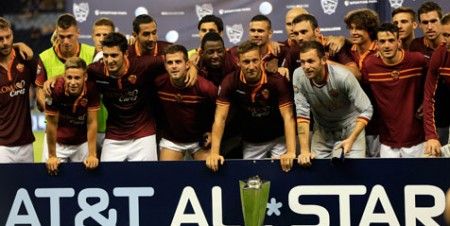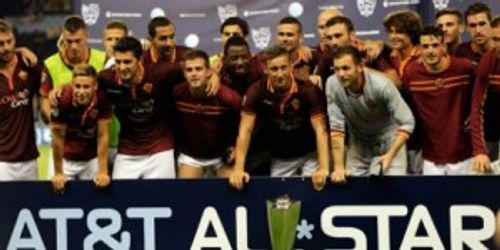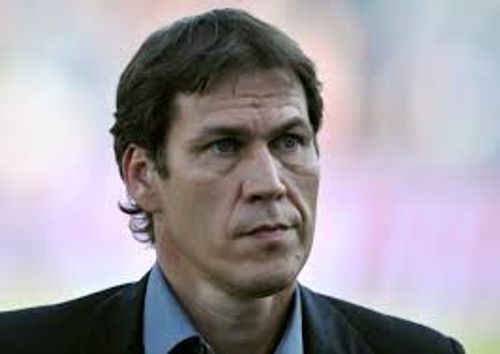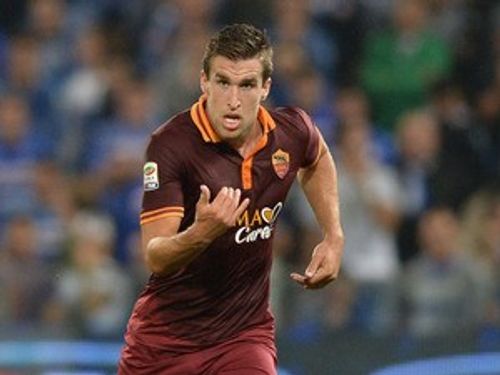
An analysis of Roma's excellent start to the season

AS Roma squad, 2013-14
No team in Europe has made as stunning a start to the season as AS Roma have. With Atletico’s defeat to Espanyol, the Romans are the sole team left in Europe’s top 5 leagues to have won all their opening games till date – eight and counting. And their position does not flatter them: it is a testament to their sheer domination of the league. They possess the strongest attack in Italy, with an incredible 22 goals scored. They’re also the strongest defensively, with just 1 goal conceded thus far.
What makes it even more amazing is that all this has been accomplished literally overnight. As recently as five months ago this was a promising but struggling young team that had underachieved the previous season. The Giallorossi squandered a good start to finish a disappointing sixth in Serie A and, to add insult to injury, lost the Coppa Italia final to bitter local rivals Lazio. Having finished outside the European places, Roma looked set to be dismantled by richer clubs.
As expected, they sold their top goalscorers (Pablo Osvaldo and Erik Lamela), their best defender (Marquinhos), a well-regarded goalkeeper (Maarten Stekelenburg) and allowed older players to retire. No player of comparable pedigree was brought in as a replacement, and Rudi Garcia was hardly a popular choice for manager (he was booed by the ultras at the team presentation on Aug 21). Yet, they have emerged from the episode a stronger, tougher fighting unit.
Let’s take a look at how Garcia has improved his team in terms of playing personnel and tactics.

Rudi Garcia
Despite having some of the most talented young individual players in Europe, Roma till recently didn’t have a balanced team. Last year, playing under attack-minded manager Zdenak Zeman, they were permanently in all-out assault mode: high pressing, vertical movement and overloading the opposition defence. While this approach has shock value if employed occasionally, it isn’t a sustainable model to follow over an entire season; neither attack nor defence were functional. Zeman was duly booted as the campaign faltered.
After a brief caretaker spell, Garcia was appointed in June. He’d won the French title with Lille in 2010-11, but was relatively new to Italian football. Garcia derives his footballing philosophy from the great Dutch sides of the 70s, but with a caveat: he likes the counter-attack. His sides are known for their slick movement, precise passing and clever use of pace, rather than being centered around a specific philosophy like Ajax or Barcelona. Roma now do a lot of their scoring by breaking with devastating ruthlessness. Unusually for a counter-attacking team, they also have the second-highest possession in the league.
Under managers like Luis Enrique, Roma had learnt to play the beautiful game, but without any real effectiveness in front of goal. Not only were they overly dependent on Francesco Totti – who in his advancing years retains his flair and cunning, but not his pace – but their disorganized backline was vulnerable to attacks down the flanks. They were outmuscled too easily in midfield, and all too often would dominate possession and still lose by two or three-goal margins.
It was one of the first problems Garcia set himself to remedy when he took over. “My objectives and football philosophy,” says Garcia, “are without doubt offensive, but I am well aware that in order to win a game you also need an excellent defensive base.”

Kevin Strootman
Dutch midfielder Kevin Strootman, who had previously been linked with Man United, was signed to steel up the midfield. A box-to-box midfielder, Strootman possesses physicality and passing ability and does plenty of running in tandem with Miralem Pjanic. An old-school playmaker, Pjanic forms the attacking apex of the Roma midfield triangle, whose third member is Daniele de Rossi.
Garcia’s midfield does everything – attack, defend, build up moves and keep the ball during quiet periods – so plenty of energy is expended by these players. There is an emphasis on quick transitions, essential for a successful counter. American midfielder Michael Bradley, another willing runner, will be an excellent backup for this zone when he returns from injury.